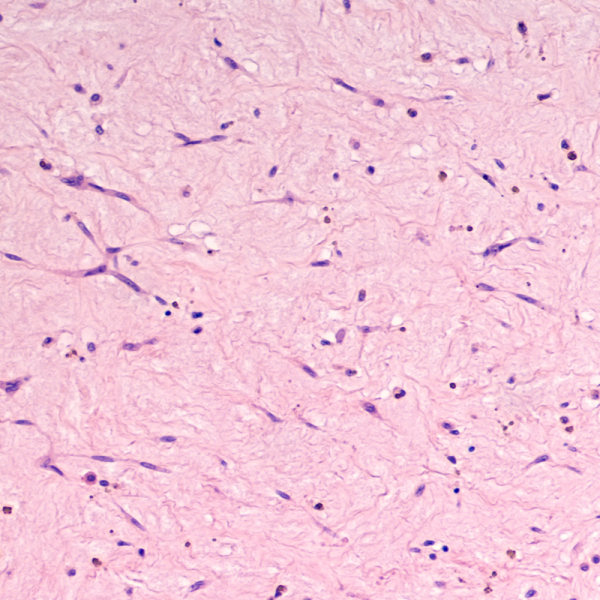
What is an angiomyxoma?
Angiomyxoma is a rare type of soft tissue tumour that can develop mainly around the genitals, the trunk or on the head and neck. Doctors distinguish between superficial and aggressive angiomyxomas. Because angiomyxomas usually grow slowly and do not spread to other parts of the body, the disease is not considered cancer.
As a rule, angiomyxomas are benign. However, there are also a small number of malignant cases. On average, the majority of all patients develop angiomyxoma by the age of 34. Although an angiomyxoma does not usually cause any symptoms, it is mostly removed surgically, if only for aesthetic reasons. Aggressive angiomyxomas in particular have a high recurrence rate, even after successful removal, which is why hormone or chemotherapy can be administered.
How does an angiomyxoma develop?
An angiomyxoma develops from a certain type of cell called a myxoid cell. Myxoid cells are types of cells that are found in connective tissue and are thought to hold organs and other body structures in place. The term "myxoma" refers to a rather rare, benign tumour that has only a small vascular supply. Doctors distinguish between a superficial and an aggressive angiomyxoma. A superficial angiomyxoma is caused by an overproduction of mucous substances that occur naturally in the skin. The exact cause of an aggressive angiomyxoma, however, is still unknown to doctors.
What are the different types of angiomyxoma?
Doctors distinguish between the two types of angiomyxoma:
- superficial angiomyxoma: This form of angiomyxoma is close to the surface and therefore directly on the skin or just under the skin surface, usually visible to the naked eye. In most cases, it occurs on the trunk, the lower parts of the body, on the genitals or on the head or neck area. People in middle age or older adults are particularly likely to get superficial angiomyxoma, which tends to grow slowly.
- aggressive angiomyxoma: This form of angiomyxoma invades deeper tissue structures and can also spread to the surrounding tissue. Aggressive angiomyxoma is particularly common between the legs (perineum) but also in the pelvic area of the affected person, i.e. in the part of the lower abdomen and inside the hip bones. Most women of childbearing age get an aggressive angiomyxoma, which grows quickly but is usually not malignant.
What are the symptoms of angiomyxoma?
Affected women often complain of pain or a feeling of pressure around the angiomyxoma. However, many people do not experience any symptoms at all. However, angiomyxomas can cause aesthetic concerns, especially in the head and neck area, which is why they are often surgically removed, even though they are medically harmless.
How is angiomyxoma diagnosed?
Diagnosing angiomyxoma can be difficult because it is a rare tumour that can often be confused with other conditions. Superficial angiomyxomas in particular can look similar to cysts, which is why the doctor should take a biopsy to confirm the diagnosis.
Many patients receive the diagnosis more as an incidental finding, for example if they have to be operated on for another disease and the angiomyxoma is detected in the process. In general, it is possible to detect an angiomyxoma with an ultrasound examination, a computer tomography (CT) or a magnetic resonance imaging (MRI). The removal of a tissue sample can then ensure a definite diagnosis.
How is an angiomyxoma treated?
If a superficial angiomyxoma does not cause any aesthetic symptoms, it can be left untreated. However, if it is located in the head or neck area, it can be surgically removed in a similar way to an aggressive angiomyxoma. However, complete surgical removal of the tumour can be difficult depending on the location, which is why hormone therapy is also used in some patients. Since the growth of some angiomyxomas is based on hormones, hormone therapy can counteract the spread of the angiomyxoma accordingly. Hormone therapy usually has the following two goals:
- 1. to completely stop the hormone production of the angiomyxoma, or
- 2. prevent the hormones of the angiomyxoma from growing and dividing.
In most cases, the hormone treatment includes goserelin and tamoxifen. These two pharmaceuticals are also used as part of chemotherapy.
In addition to treating an angiomyxoma, hormone treatment can also be given before the angiomyxoma is surgically removed. This is mainly to facilitate the removal of a large tumour. But hormone therapy is also recommended for the surgical follow-up treatment of an angiomyxoma in order to reduce the risk of the tumour recurring in the same place. Especially the recurrence rate of superficial angiomyxomas can be significantly reduced by this. However, as hormone treatment is a relatively new therapeutic measure, the duration of taking the hormone preparations is still unexplored. In many patients, tumour growth returned after the hormone therapy was stopped. In aggressive angiomyxomas, this is already the case after six months.
What is the prognosis for angiomyxoma?
If the angiomyxoma could not be completely removed, there is a high probability that the tumour will recur at the same site (high risk of recurrence). This risk is relatively high in almost 30 per cent of all aggressive angiomyxomas, even after complete removal of the tumour. On average, the angiomyxoma will form again in exactly the same place after about six months. In most cases, the angiomyxoma is then removed again surgically, because angiomyxomas usually only form again once. Hormone therapy or chemotherapy can reduce the risk of a new growth.
| Pathogen | Source | Members - Area |
|---|---|---|
| Angiomyxoma | EDTFL | As a NLS member you have direct access to these frequency lists |
